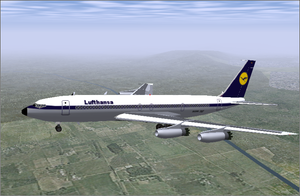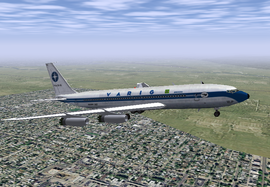Boeing 707-400: Difference between revisions
(fixed templates) |
m (Restyling. Removed Development section: unrelated to 707-400.) |
||
| Line 1: | Line 1: | ||
{{Languages|Boeing 707-400}} | {{Languages|Boeing 707-400}} | ||
{{non-stable}} | {{non-stable}} | ||
| Line 6: | Line 5: | ||
{{infobox Aircraft | {{infobox Aircraft | ||
|image = 707-400.png | |image = 707-400.png | ||
|alt =Lufthanse 707-400 | |||
|name =Boeing 707-400 | |name =Boeing 707-400 | ||
|livery =Lufthansa, Varig PAX, Varig Cargo, Qantas | |livery =Lufthansa, Varig PAX, Varig Cargo, Qantas | ||
|type =Airliner | |type =Airliner | ||
|fdm =JSBsim | |fdm =JSBsim | ||
|status = | |status =Alpha | ||
|authors = Isaias V. Prestes, Innis Cunningham, Erik Hofman (FDM) | |authors = Isaias V. Prestes, Innis Cunningham, Erik Hofman (FDM) | ||
|fgname =707-400 | |fgname =707-400 | ||
|download =http://presteshangar.wikidot.com/boeing-707-400 | |download =http://presteshangar.wikidot.com/boeing-707-400 | ||
}} | }}[[File:707-400b.png|270px|thumb|right|The VARIG 707-400 PAX]] | ||
''This includes the following models: 707-400'' | ''This includes the following models: 707-400'' | ||
The '''Boeing 707''' is a four-engine commercial passenger jet [[:Category:Airliners|airliner]] developed by [[:Category:Boeing|Boeing]] in the early 1950s. Its name is most commonly pronounced as "Seven Oh Seven". Boeing delivered a total of 1,010 Boeing 707s, and also offered a smaller, faster model of the aircraft that was marketed as the Boeing 720. | |||
The Boeing 707 is a four-engine commercial passenger jet airliner developed by Boeing in the early 1950s. Its name is most commonly pronounced as "Seven Oh Seven". Boeing delivered a total of 1,010 Boeing 707s, and also offered a smaller, faster model of the aircraft that was marketed as the Boeing 720. | |||
The '''707-420''' is a version of the 707-320 originally produced at specific request for BOAC and powered by '''Rolls-Royce Conway 508 turbofans''', producing 17,500 lbf (77.8 kN) each. Although BOAC initiated the programme, Lufthansa was the launch customer and Air India was the first to receive a 707-420 on February 18, 1960. A total of 37 were built to this configuration. | |||
The '''707-420''' is a version of the 707-320 originally produced at specific request for BOAC and powered by '''Rolls-Royce Conway 508 turbofans''', producing 17,500 lbf (77.8 kN) each. Although BOAC initiated the programme, | |||
== External Links == | == External Links == | ||
* [http://www.boeing.com/commercial/707family/ Boeing 707 family on Boeing.com] | * [http://www.boeing.com/commercial/707family/ Boeing 707 family on Boeing.com] | ||
* [http://www.airlinercafe.com/page.php?id=72 Detailed guide to all variants of the 707/720 on airlinercafe.com] | * [http://www.airlinercafe.com/page.php?id=72 Detailed guide to all variants of the 707/720 on airlinercafe.com] | ||
| Line 47: | Line 27: | ||
== Reference == | == Reference == | ||
* [ | * [http://en.wikipedia.org/wiki/Boeing_707 Wikipedia] | ||
{{Boeing}} | {{Boeing}} | ||
Revision as of 17:35, 27 October 2009
| This article describes content/features that may not yet be available in the latest stable version of FlightGear (2020.3). You may need to install some extra components, use the latest development (Git) version or even rebuild FlightGear from source, possibly from a custom topic branch using special build settings: This feature is scheduled for FlightGear (unknown). If you'd like to learn more about getting your own ideas into FlightGear, check out Implementing new features for FlightGear. |
 Lufthanse 707-400 | |
| Type | Airliner |
|---|---|
| Author(s) | Isaias V. Prestes, Innis Cunningham, Erik Hofman (FDM) |
| FDM | JSBSim |
| --aircraft= | 707-400 |
| Status | Alpha |
| Download |
|
This includes the following models: 707-400
The Boeing 707 is a four-engine commercial passenger jet airliner developed by Boeing in the early 1950s. Its name is most commonly pronounced as "Seven Oh Seven". Boeing delivered a total of 1,010 Boeing 707s, and also offered a smaller, faster model of the aircraft that was marketed as the Boeing 720.
The 707-420 is a version of the 707-320 originally produced at specific request for BOAC and powered by Rolls-Royce Conway 508 turbofans, producing 17,500 lbf (77.8 kN) each. Although BOAC initiated the programme, Lufthansa was the launch customer and Air India was the first to receive a 707-420 on February 18, 1960. A total of 37 were built to this configuration.
External Links
- Boeing 707 family on Boeing.com
- Detailed guide to all variants of the 707/720 on airlinercafe.com
- Boeing 707 page on Airliners.net
Reference
| |||||||||||
